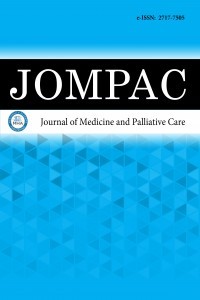Tanı anında eritema nodozum ve pyoderma gangrenozum birlikteliği ile prezente olan ülseratif kolit vakası
İnflamatuvar barsak hastalığında ekstraintestinal bulgular %25-30 oranında görülmektedir. En sık tutulan organlar eklem, cilt ve göz’dür. Cilt tutulumu olarak en sık gördüğümüz lezyonlar eritema nodozum (Crohn hastalığında daha sık) ve pyoderma gangrenozum (ülseratif kolitte daha sık)’dur. Sadece Crohn hastalığında değil, ülseratif kolitte de bu lezyonların birlikte olabileceği göz önünde bulundurulmalıdır. Hatta bu cilt lezyonları ülseratif kolit tanısından çok daha önce ortaya çıkabilmektedir. İki lezyonun birlikteliği oldukça nadirdir. İki lezyonun da birlikte olduğu durumlarda, ayırıcı tanıda ilk akla gelecek hastalıklar arasında inflamatuvar barsak hastalığı da yer almalıdır.
Anahtar Kelimeler:
Ülseratif kolit, eritema nodozum, pyoderma gangrenozum
Case of ulcerative colitis presented at the time of diagnosis with erythema nodosum and pyoderma gangrenosum
In inflammatory bowel disease, extraintestinal findings are seen in 25-30%. The most frequently involved organs are joints, skin and eyes. The most common lesions we see as skin involvement are erythema nodosum (more often in Crohn's disease) and pyoderma gangrenosum (more often in ulcerative colitis). It should be taken into consideration that these lesions may coexist not only in Crohn's disease but also in ulcerative colitis. In fact, these skin lesions can appear much earlier than the diagnosis of ulcerative colitis. The coexistence of the two lesions is extremely rare. In cases where both lesions are present, inflammatory bowel disease should be among the first diseases that will come to mind in the differential diagnosis.
Keywords:
Ulserative colitis, erythema nodosum, pyoderma gangrenosum,
___
- 1. Stathers GM, Abbott LG, Mcguınness AE. Pyoderma gangrenosum in association with regional enteritis. Archives Dermatol (Chicago) 1967; 95: 365.
- 2. Gellert A, Green ES, Beck ER, Ridley CM. Erythema nodosum progressing to pyoderma gangrenosum as a complication of Crohn's disease. Postgraduate Med J 1983 Dec; 59: 791-3.
- Başlangıç: 2020
- Yayıncı: MediHealth Academy Yayıncılık
Sayıdaki Diğer Makaleler
Güray CAN, Ayten ÜSTÜNDAĞ, Gülbin ÜNSAL, Ali Rıza SOYLU, Hasan Celalettin ÜMİT, Hüseyin Ahmet TEZEL
Hasta değerlendirmede hekimlik sanatı: semptoma multisistemik yaklaşım
Hepatorenal sendromlu hastada terlipressin’e bağlı skrotal ağrı
Rabia EZBER, Güray CAN, Zuhal MERCAN, Gizem KAHVECİ, Fatime DEMİR, Müjgan GÜRLER, Meral AKDOĞAN KAYHAN
Tip 2 diyabette yeni tedavi yaklaşımları: olgu örnekleriyle bakış
